This spring has blossomed with numerous adventurous concerts and performances, including several world and U.S. premieres, with works presented by the Repertory Dance Theatre, Sackerson and NOVA Chamber Music Series.
SACKERSON: SCARLET
For a small theatrical company without a permanent home, Sackerson has managed consistently to electrify the Salt Lake City performing arts scene with productions of original plays by Utah writers as well as regional and U.S. premieres of work from abroad. Last fall, the company’s production of Shockheaded Peter, with regional premiere rights from the London-based Cultural Industry, was a fiendishly good cabaret. This spring brought Etiquette, a pop-up production from Rotozaza in London, that upends every convention of theater as audiences know it.

Now, each Saturday through the end of April at Avenues Yoga (a venue that the company has used before in the city), Sackerson has been presenting the U.S. premiere of Scarlet, a 2015 play by Sam Freeman, which touches on issues of revenge porn, cyberbullying, shaming and sexual abuse. The company’s production is an excellent example of how astute direction (courtesy of Lisa Hall Hagen, the chair of Utah Valley University’s department of theater and assisted by Elizabeth Golden) and a magnificent ensemble (Whitney Black, Kat Hawley, Merry Magee and Hailey Nebeker) elevate a script that sometimes falls short of the fascinating potential of casting four actors to capture the complexities of a single character.
The show, which moves at a bristling pace in two acts, centers around Scarlet, a character in which each of the four characters portray parts of her psyche. They also act out the characters central to her story including her boyfriend (Daniel), her close friend (Sasha) and Will, an awkward, insecure acquaintance who seeks revenge against Scarlet after being mocked at in an incident where she was present.

The script essentially is a monologue – an extended storytelling experience that one might hear on public radio’s popular show The Moth Radio Hour. However, in this case, the length is much longer (70 minutes) and the story is fictional but the events, indeed, are realistic. And, when we hear Scarlet recall events through the other characters, it is exclusively her interpretation.
The idea of four actors playing the same character and switching abruptly to other individuals central to the story might risk bewilderment and confusion for some audience members. But, the actors do this so well consistently that the audience can quickly find the groove to follow the rapid pace of the action and comprehend the inner conflict Scarlet navigates. And, the intimate setting of the Avenues Yoga studio gives audience members clear view of the actors’ gestures and movement, choreographed nicely by Chantelle Wells.
The audience warms quickly to Scarlet in the opening exchange. She talks about Daniel, “the first person I ever said the words ‘I love you’ to, (apart from my mom).” Actually, she was “five weeks behind” him in saying the words. The story begins, however, as Scarlet explains, with Will, whom she met before she started dating Daniel. She was supposed to meet her friend Sasha for drinks, who canceled, but Scarlet decided to go to the bar and that is where she saw Will.
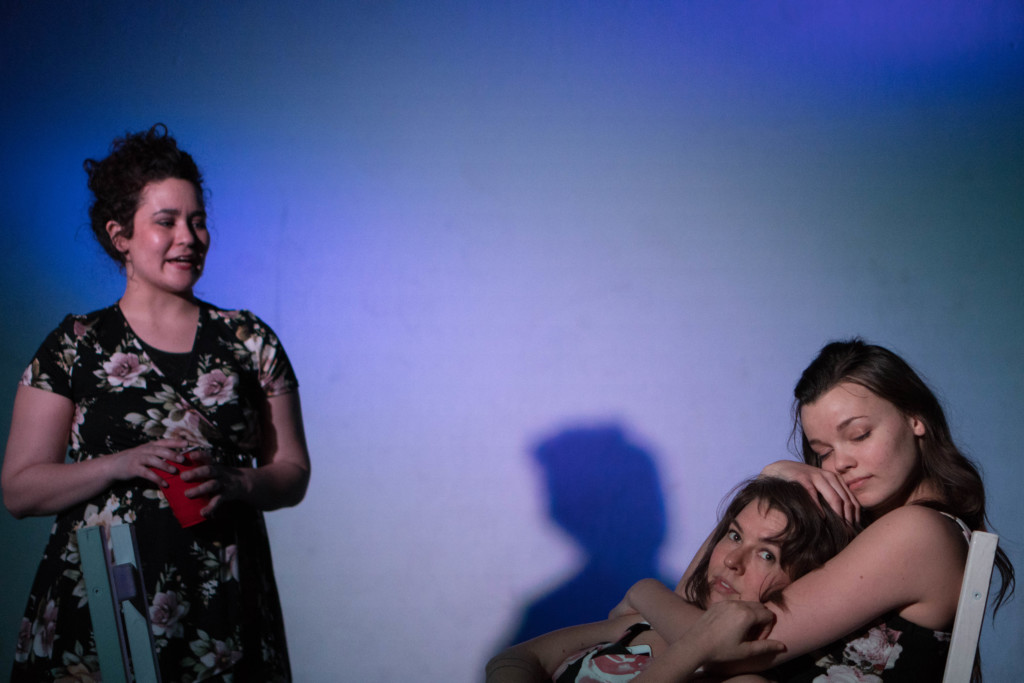
Her description of him is blunt: “His face looks a little bit like he might be inbred. And he smells like a farm. I’m pretty sure the joke must be on him.” However, indicating that she is a nice person, she decides to chat with Will over a pint. She recalls that she was specific enough not to misinterpret any intentions: “A nice, friendly laugh that very clearly says ‘I like you, I respect you, but I do not necessarily want to have sex with you.’”
Things from that point become problematic for Scarlet – and, in many instances obfuscate the initial, and most significant, premise of the play. The sex video in question is taken down from social media after several days and Scarlet believes she will weather the initial embarrassment, believing that it was just “a cruel joke played by a sad, bitter boy.” Scarlet is more concerned at this point about Daniel, adding that she feels responsible for what happened.
But the situation worsens for Scarlet and the inner conflict in her psyche is roiling before the end of the first act. Upset that Daniel wants to end the relationship, she uploads sexually explicit photos of him to cyberspace – an act that he brushes off casually.
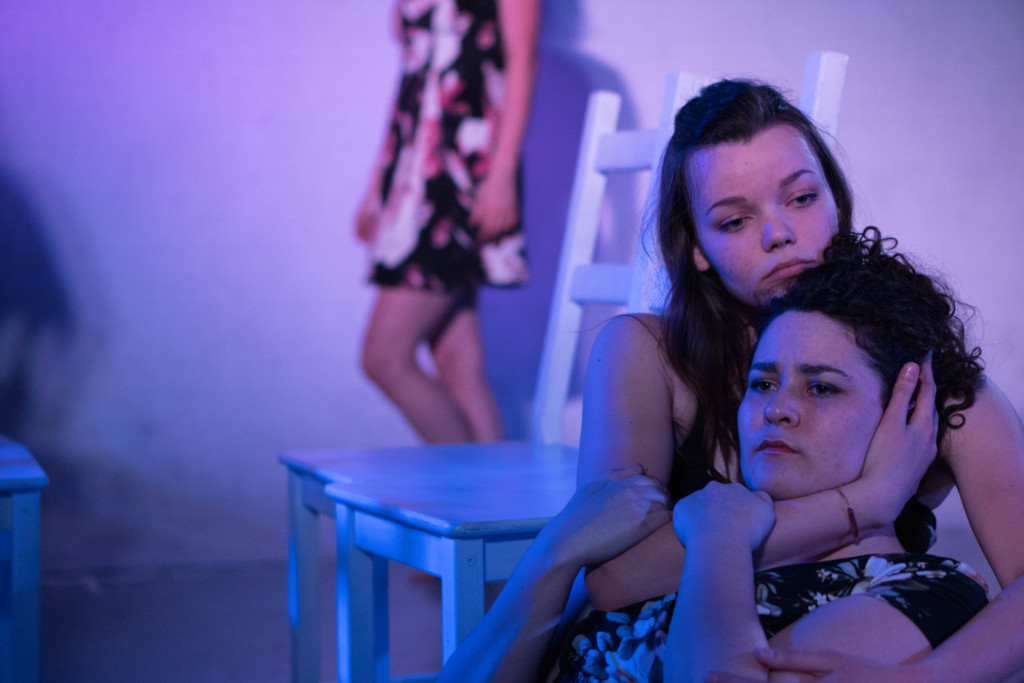
The second act opens with Scarlet trying to move on from earlier events. She is now Eleanor and there are changes in the actors. Three have changed their look, dressed in muted tones. The fourth still is dressed in the same flowery dress that the ensemble wore in the first act, when all four Scarlets were equal. The trio ignores the outcast, as if she does not exist. Each member of the new Eleanor trio has a specific function: one leads the way, while another is her loyal aide and the third desperately seeks affirmation from the other two. The new equilibrium is short lived, however, as Scarlet must confront the irrevocable effects of a personal tragedy that is still in progress. Memories of defiance never can heal completely the pain that has occurred.
Freeman’s play is important and valuable, as evidenced by Sackerson’s excellent rendering of a provocative work. However, the script compromises the full force of the complex and intensely emotional relationships that Scarlet attempts to work through, given how they typically are bound and arrested by their dark secrets; the silence invoked to deflect personal shame, humiliation and embarrassment and the reluctance to confront and resolve the pain and harm on her terms.
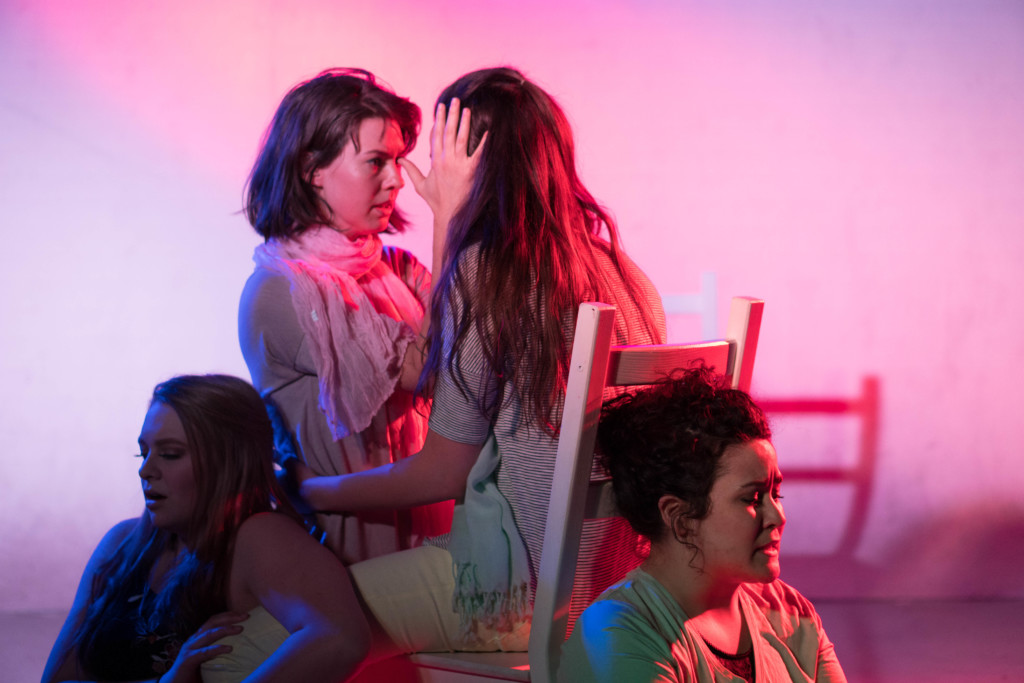
It attempts to convey victim status in equal ways to all of the characters involved. Freeman certainly produces a credible telling. Often perpetrators and their victims, along with those who are witnesses by accident or otherwise, are not strangers. Scarlet struggles with an immensely complicated objective, which is trying to disentangle the relationship from the harm that has occurred through the relationship. That process is as painful as the harm itself. And, the challenge is not made easier if one attempts to legitimize or rationalize the perpetrators of the harmful behaviors in the first place.
Performances continue on Saturdays at 8 p.m. through the end of the month. For more information, see the Sackerson website.
REPERTORY DANCE THEATRE: CURRENT AND DABKE
Judging by the response and overheard comments from audience members, Current, the closing concert for Repertory Dance Theatre’s 52nd season, succeeded in making contemporary dance accessible, entertaining and emotionally touching. Each of the five works, including two world premieres, was easy to grasp. The concert promised to show what current choreographers, including three RDT alumni, strive to achieve in their artistry.
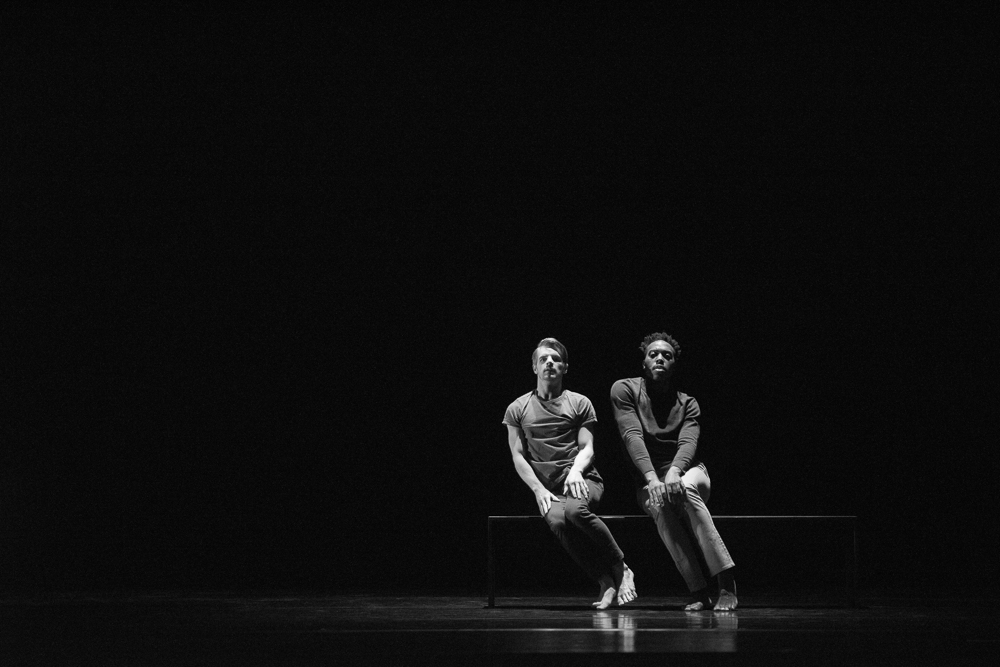
Current revealed a sensitive, adept capacity for dance as an ideal form for the art of transmedia storytelling, where engagement and collaboration outweigh autonomy, different layers of depth are incorporated and foresight and conscious awareness are crucial, as we discover how old cultural narratives no longer suffice our needs of humanity.
One of the most curious revelations was how the dancers carried through the emotional potential in each work with finesse and cohesion. It was the penultimate performance for this company’s current slate of dancers, who have been together for five seasons. After this season, Justin Bass and Lacie Scott are leaving to pursue new paths.

The concert opened with Sarah Donohue’s Still Life with Flight, a work that the RDT alumna created several years and has included prior performances with the company as well as the 2016 American College Dance Association’s National Festival at the Kennedy Center in Washington D.C. For the closing night performance, Bass and Tyler Orcutt, the two dancers who have been with RDT the longest, set the evening’s expectations in exquisite execution of technique.
Often lighthearted, even whimsical, but still tempered with just the right sobering touch of depth, the work comprises a playful competitive tone between the two dancers as they move on and off a bench that could easily be a plain bus stop. But, one dancer even as he might appear to one-up the other, it never happens. And, both are on the same level. The dance’s total effect comes through with the marvelous eye communication between Bass and Orcutt, augmented by musical excerpts from various sources including Vivaldi’s Spring from the Four Seasons and local composer Michael Wall.

The concert included two emotionally powerful works by Francisco Gella, who danced with RDT during the late 1990s and now is a nationally known choreographer and teacher based in Los Angeles. In Aloneness, a world premiere filled with movement that blends the ballet and contemporary dance languages in fine synergy, Gella renders a choreographed reflection that captures the authentic heart of an illustrated children’s book of poetry of the same name by the late Gwendolyn Brooks.
The ensemble piece, which includes solos and duets, incorporates a mirror as the mise en scène element, emphasizing the spectrum of sensory reactions to the ideas of solitude and loneliness about which Brooks writes. The dancers were acutely sensitized to Gella’s creative objectives. In the book, Brooks writes lyrics with the metaphorical connection to a pond in the summer. The mirror is a difficult prop to manage on stage but it also conveys images of muted and piercingly brilliant reflections. The music conveys heartache and consolation through excerpts by two titans of the late Romantic Era (Franz Liszt and Gustav Mahler) and contemporary composers, Ryoji Ikeda and Christopher Filippi.

Gella’s other work was a reprise of Schubert’s eight Impromptu pieces (Op. 90 No. 3 in G flat major), a piece for two dancers (Justin Bass and Jaclyn Brown) that the company premiered in 2015. Conceived as a tribute to his grandmother, who loved the music, Impromptu as a dance replicates precisely the serene poignance and the rippling modulations of the music which occur through harmonic movement rather than amplification of sound. Bass and Brown responded to the demands with exceptional respect and technique.
The Impromptu provided the consoling emotional relief in the second half following the world premiere of Flood, choreographed by Nichele Van Portfleet, the winner of RDT’s Regalia competition who was chosen by the audience in 2017. Flood intrigues in many ways, as it synthesizes an artistic interpretation of scientific principles of entropy, momentum, attraction and energy in humanistic context of our own relationships with chaos. The dancers are kinetic and restless, the agitation underscored by a dark but still lyrically flowing musical score taken from Icelandic composer Anna Thorvaldsdottir.
It is fascinating to consider the impetus a choreographer relies on to choose her music for achieving a particular theme and tone in the dance composition. Van Portfleet’s musical selection differed dramatically from those incorporated in the concert’s other four works. The dancers responded on point with movement that respects the complex demands of the recorded music, which is as gritty and anxious as it is tactile and luminescent. The world premieres of Aloneness and Flood on the same concert make for smart programming that engages both ends of the audience’s emotional spectrum of response.

And, the closing piece provided a compelling counterpoint as a companion tribute piece. Where Gella’s Impromptu approaches hymn-like status in honoring the memory of his grandmother, Angela Banchero-Kelleher’s Material Tokens of the Freedom of Thought is a visceral, complicated reflection on the relationship the choreographer had with her late mother. Banchero-Kelleher, also an RDT alumna, reset the work, which the company premiered three years ago.
The work for the company ensemble included the duet by Dan Higgins and Jaclyn Brown, which underscored the turbulent yet genuine loving dynamics of the relationship the two enjoyed. Accompanied by music with a cinematic feel written by Wojciech Kilar, a 20th and 21st century Polish composer, the dancers gave Material Tokens a full-blooded interpretation that yanked away the surrealistic sense of the original version and placed it into a realistic, approachable contemplation.
The quality of Current’s performances capped a grueling, thrilling season for RDT. It is notable how dancers have tightened and honed their execution of movement in works they have performed one, two, or three years ago. Last month, the company presented several performances of Dabke, a work by Zvi Gotheiner that premiered in 2017. The latest performances were given in the Black Box Theatre of the Rose Wagner Center for Performing Arts – an excellent venue to experience the work, which includes an original musical score by Scott Killian and dabke folk music by Ali El Deek.
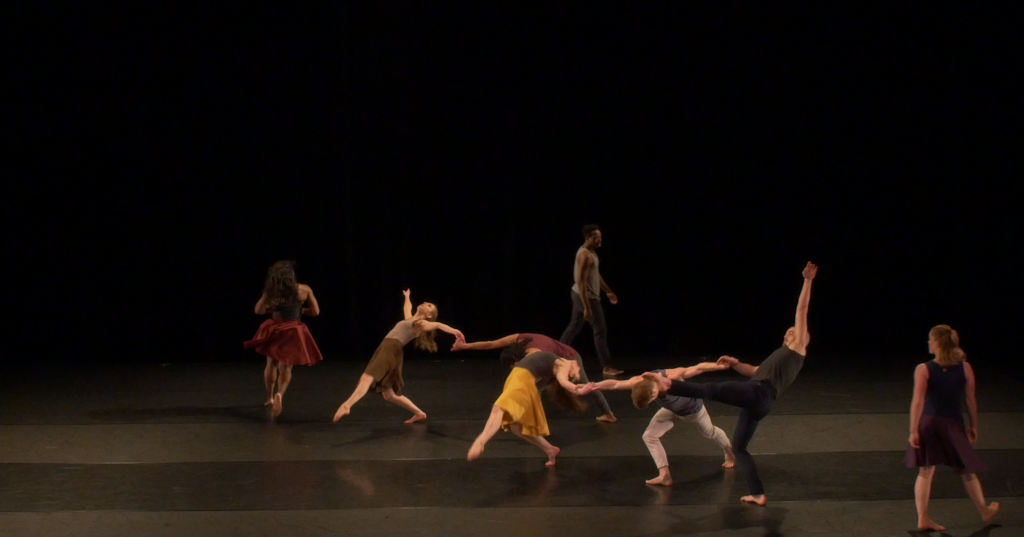
Dabke is considered the national dance of Syria and Lebanon but it also is an integral aspect of Jordanian and Palestinian cultures as well as Israel and other Middle East countries. As mentioned in a 2017 feature in The Utah Review, Dabke embodies a versatile spectrum of distinct cultural identities with emotional responses that are as varied as the dance form. In Israel, the dance has been interpreted in a form known as debka, often to mark the desire of returning to one’s homeland. The dabke is danced at weddings and celebrations. It also represents for some an affirming form of resistance and protest. In its simplest form, it is usually a line of men with their arms linked while they stomp rhythmically, following a leader, who improvises the steps and gestures with a baton, scarf or string of beads.
Gotheiner sets the work with a tone that epitomizes the frustrating geopolitical conflict of the region encompassing his Israeli homeland and the surrounding neighbors. The dancers exemplify this with vivid acuity. They bring to bear the embedded prejudices along with distrust and anger matched up against the background feelings of resignation and skepticism. Their movements, eye contacts and extra gestures fortify the theatrical power of the work. If the political will is antagonistic about the possibility of reconciliation, then unmodulated artistic expression might be the way to dislodge an entrenched sense of hopelessness.

The current RDT’s dancers have worked previously with Gotheiner, most prominently for the season opener, which included the phenomenal Dancing The Bears Ears and for last year’s premiere of Dabke. In this latest series of Dabke performances, it was striking to see how the dancers fully integrated themselves with the cultural underpinnings that shape the multifaceted interwoven themes of this piece. Their extensive familiarity with Gotheiner added to the performance’s exhilarating complexities.
NOVA CHAMBER MUSIC SERIES: BACH AND NEW HORIZONS
For Jason Hardink, NOVA Chamber Music Series’ artistic director, the Bach and New Horizons concert was his valedictory statement before he turns the leader’s reins over to Madeline Adkins, Utah Symphony concertmaster, for the next season.
The April 15 concert was lit in every moment, which included Hardink’s appearance as keyboard soloist in works by J. C. Bach and a new commission composed by Inés Thiebaut of The University of Utah, along with a performance of Jason Eckardt’s Toll for piano four hands. For that last work, Hardink was joined by his wife, Kimi Kawashima.

Hardink’s tenure as NOVA’s artistic director has been marked by numerous examples of imaginative programming that juxtaposed new and old music in ways, which awakened audiences to appreciate earnestly ground-breaking 21st century music while discovering different dimensions about composers more familiar to them.
This latest experiment involving music by Bach and his son J.C. Bach popped with grand results. The first half opened with the interwoven movements of Bach’s Suite in G Major for Unaccompanied Cello, BWV 1007, composed 300 years ago and György Kurtág’s Signs, Games and Messages for Solo Viola, which the Hungarian composer worked on fastidiously over the course of more than 40 years, starting in the 1960s.

The musical dialogue worked fabulously, thanks to the husband-wife team of soloists – Brant Bayless, Utah Symphony’s principal violist, and Anne Francis Bayless, cellist with The Fry Street Quartet. The movement match-ups echoed each other perfectly in character and tone. Each of the Bach cello suite movements was played in order but there was plenty of freedom in deciding which Kurtág movements – or more accurately, musical postcards — to insert. For example, after the cello’s second movement, Allemande, which encompasses a great deal of wandering melodic and harmonic phrases, the viola plays Kurtág’s Homage à John Cage – Faltering Words, a poignant fragment which also shows the possibilities of wandering, followed by a fragment titled Doloroso. The cello’s final movement, Gigue, is followed by Kurtág’s The Carenza Jig, which he wrote in honor of a musically gifted eight-year-old girl. Its swift, unrestrained feel punctuated this musical experiment perfectly.
Toll, Eckardt’s 2016 work for piano four hands, was a surprising late addition. It made sense: Eckardt composed it as part of a celebration for Kurtág’s 90th birthday and the composer also had a 2014 NOVA commission, pulse-echo, which Hardink premiered. In Toll, Hardink played at the keyboard and Kawashima stood at the piano’s tail, creating sounds from inside the instrument. The effect of the extended techniques accentuated the dark solemnity of the piece and the lower register sonoroties came through exceptionally well even in the bright live sound of Libby Gardner Concert Hall. Eckardt, currently on the faculty of City University of New York’s Conservatory of Music at Brooklyn College, is a composer who always produces intricate music that evokes strong emotional expression and connection. Toll is just a brief sample of his outstanding portfolio.

While darker sonorities dominated the program, the performance of J. C. Bach’s Concerto for Piano and Strings in E-Flat, Opus 7, No. 5 briefly lightened the sound with the prototypical elegance to be expected in a 1770 work composed in a charming galant style. The instrumentation for the accompaniment still added a deeper hue to the sound with just one violin (David Langr) pitted against the rest of the players (Bayless, viola: Noriko Kishi, cello; Corbin Johnston, bass). And, Hardink surprised the audience in the first movement cadenza, breaking briefly away with a thunderous passage that jolted the audience briefly from the work’s subdued charming intimacy. The gesture, which brought a few chuckles from the audience, was a spontaneous homage to Cecil Taylor, the amazing jazz pianist, who died earlier this month and who often surprised audiences by transforming banal and timid sounds into explosive keyboard explorations.
For his final appearance as NOVA’s artistic director, Hardink asked Thiebaut to compose a commission that would make him sweat. NOVA’s 40th anniversary season has included numerous commissions but Hiraeth, a work for piano and accompaniment by instruments all in the lower registers, capped the string of this season’s premieres in exceptional style. Thiebaut composed the work, as indicated previously in The Utah Review, along the lines of the older Bach’s Brandenburg Concerto No. 5 in D Major, BWV 1050,in which the keyboard eventually breaks away in the first movement with a dazzling and finger-tangling cadenza.

In Hiraeth, which is a Welsh word that translates roughly to a deep longing sense, Thiebaut starts the work – complex but with crystal clarity throughout — with the piano solo and the accompaniment in customary fashion but the piece unfolds organically with Hardink eventually taking full command. The accompaniment joined the three musicians from the previous piano concerto — Bayless, viola; Kishi, cello; Johnston, bass – with trombonists Mark Davidson and Sam Elliot, Utah Symphony principal and associate principal, respectively.
The work moves quickly but Thiebaut builds so many ideally dark textures with each instrumentalist by using various extended effects throughout the piece. The nature of its creation as an homage to Bach and as a tribute to Hardink’s significant aesthetic approach as NOVA’s artistic director was a solid choice. Thiebaut’s commission brought full circle the concert’s ambitions that were achieved in the first half with the Bach-Kurtág juxtaposition.
NOVA will close out its landmark anniversary season on May 6 with a concert of works by Schubert, Messiaen and Lutoslawski and featuring numerous Utah musicians including Adkins.

